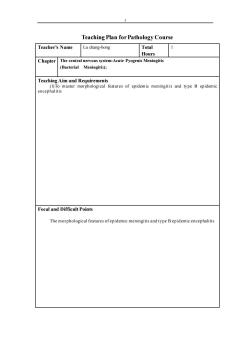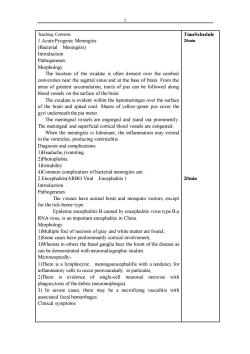重庆医科大学:《病理学》课程教学资源(授课教案)disease of nevous system_2

Teaching Plan for Pathology Course Teacher's Name Lu chang-hong Total Hours Chapter The central nervous system:Acute Pyogenie Meningitis (Bacterial Meningitis); Teaching Aim and Requirements master morphological feaures of epidemic meningitis and type B epidemic encepha Focal and Difficult Points The morphological features ofepidemic meningitis and type Bepidemicencephalitis
1 Teaching Plan for Pathology Course Teacher’s Name Lu chang-hong Total Hours 1 Chapter The central nervous system:Acute Pyogenic Meningitis (Bacterial Meningitis); Teaching Aim and Requirements (l)To master morphological features of epidemic meningitis and type B epidemic encephalitis Focal and Difficult Points The morphological features of epidemic meningitis and type B epidemic encephalitis

Teachine Contents TimeSchedule 20min (Bacterial Introduction Pathogeneses Morphology The location of the exudate is often densest over the cerebral convexities near the sagittal sinus and at the base of brain.From the areas of greatest accumulation,tracts of pus can be followed along blood vessels on the surface of the brain. The exudate is evident within the leptomeninges over the surface of the brain and spinal cord.Sheets of yellow-green pus cover the gyri undemeath the pia meter The meningeal vessels are engorged and stand out prominently. The meningeal and superficial cortical blood vessels are congested. When the meningitis is fulminant,the inflammation may extend to the ventricles,producing ventriculitis. 2)Photophobia 3)Irritability 4)Common complication of bacterial meningitis are: 2.Encephalitis(ARBO Viral Encephalitis) 20min Introduction Pathogeneses The viruses have animal hosts and mosquito vectors,except for the tick-borne type. Epidemic encephalitis B caused by encephalitis virus type B.a RNAvirus,is an important encephalitis in China Morphology 1)Multiple foci of necrosis of gray and white matter are found; 2)Some cases have predominantly cortical involvement, 3)Whereas in others the basal ganglia bear the brunt of the disease as can be demonstrated with neuroradiographic studies Microscopically, 1)There is a lymphocytic meningoencephalifis with a tendency for inflammatory cells to occur penivascularly.in particular, 2)There is evidence of single-cell neuronal necrosis with phagocytosis of the debris(neur ophogia). 3)In severe cases,there may be a necrofizing vasculitis with associated focal hemorrhages. Clinical symptoms
2 Teaching Contents 1.Acute Pyogenic Meningitis (Bacterial Meningitis) Introduction Pathogeneses: Morphology The location of the exudate is often densest over the cerebral convexities near the sagittal sinus and at the base of brain. From the areas of greatest accumulation, tracts of pus can be followed along blood vessels on the surface of the brain. The exudate is evident within the leptomeninges over the surface of the brain and spinal cord. Sheets of yellow-green pus cover the gyri underneath the pia meter. The meningeal vessels are engorged and stand out prominently. The meningeal and superficial cortical blood vessels are congested. When the meningitis is fulminant, the inflammation may extend to the ventricles, producing ventriculitis. Diagnosis and complications 1)Headache, (vomiting 2)Photophobia 3)Irritability 4)Common complication of bacterial meningitis are: 2.Encephalitis(ARBO Viral Encephalitis ) Introduction Pathogeneses The viruses have animal hosts and mosquito vectors, except for the tick-borne type. Epidemic encephalitis B caused by encephalitis virus type B,a RNA virus, is an important encephalitis in China. Morphology 1)Multiple foci of necrosis of gray and white matter are found; 2)Some cases have predominantly cortical involvement, 3)Whereas in others the basal ganglia bear the brunt of the disease as can be demonstrated with neuroradiographic studies. Microscopically, 1)There is a lymphocytic meningoencephalifis with a tendency for inflammatory cells to occur penivascularly. in particular, 2)There is evidence of single-cell neuronal necrosis with phagocytosis of the debris (neuronophogia). 3) In severe cases, there may be a necrofizing vasculitis with associated focal hemorrhages. Clinical symptoms TimeSchedule 20min 20min

Teaching Methods Multimedia and explanations
3 Teaching Methods Multimedia and explanations
按次数下载不扣除下载券;
注册用户24小时内重复下载只扣除一次;
顺序:VIP每日次数-->可用次数-->下载券;
- 重庆医科大学:《病理学》课程教学资源(授课教案)disease of nevous system_1.doc
- 重庆医科大学:《病理学》课程教学资源(授课教案)the Diseases of female genital system.doc
- 重庆医科大学:《病理学》课程教学资源(授课教案)infectious disease.doc
- 重庆医科大学:《病理学》课程英文试卷(答案).doc
- 重庆医科大学:《病理学》课程英文试卷(试题).doc
- 重庆医科大学:《病理学》课程作业习题(英文,无答案).doc
- 重庆医科大学:《病理学》课程教学实习指导(英文).doc
- 重庆医科大学:《病理学》课程课程教学大纲 A Teaching Outline for Pathology Course.doc
- 重庆医科大学:《病理学》课程理论教学大纲(供七年制和五年制使用).doc
- 重庆医科大学:《病理学》课程教学资源(PPT课件)传染病与寄生虫病(infectious desease and parasitosis).ppt
- 重庆医科大学:《病理学》课程教学资源(PPT课件)神经系统疾病(Diseases of the CNS).ppt
- 重庆医科大学:《病理学》课程教学资源(PPT课件)内分泌系统疾病.ppt
- 重庆医科大学:《病理学》课程教学资源(PPT课件)女性生殖系统疾病(disease of female reproductive system and breast).ppt
- 重庆医科大学:《病理学》课程教学资源(PPT课件)泌尿系统疾病 Diseases of urinary system.ppt
- 重庆医科大学:《病理学》课程教学资源(PPT课件)消化系统疾病 Digestive system disease.ppt
- 重庆医科大学:《病理学》课程教学资源(PPT课件)呼吸系统疾病.ppt
- 重庆医科大学:《病理学》课程教学资源(PPT课件)心血管疾病 Diseases of Cardiovascular system.ppt
- 重庆医科大学:《病理学》课程教学资源(PPT课件)肿瘤(tumor, neoplasm).ppt
- 重庆医科大学:《病理学》课程教学资源(PPT课件)炎症 inflammation.ppt
- 重庆医科大学:《病理学》课程教学资源(PPT课件)局部血液循环障碍.ppt
- 重庆医科大学:《病理学》课程教学资源(授课教案)diseases of cardiovascular system.doc
- 重庆医科大学:《病理学》课程教学资源(授课教案)diseases of respiratory system.doc
- 重庆医科大学:《病理学》课程教学资源(授课教案)disease of alimentary system.doc
- 重庆医科大学:《病理学》课程教学资源(授课教案)disease of urinary system.doc
- 重庆医科大学:《病理学》课程教学资源(授课教案)cell adaptation and injury, repair.doc
- 重庆医科大学:《病理学》课程教学资源(授课教案)tumor.doc
- 重庆医科大学:《病理学》课程教学资源(授课教案)Introduction and hemodynamic rearangment.doc
- 重庆医科大学:《病理学》课程教学资源(授课教案)inflammation.doc
- 重庆医科大学:《病理学》课程教学资源(授课教案)内分泌系统疾病.doc
- 重庆医科大学:《病理学》课程教学资源(授课教案)传染和寄生虫病.doc
- 重庆医科大学:《病理学》课程教学资源(授课教案)女性生殖系统疾病.doc
- 重庆医科大学:《病理学》课程教学资源(授课教案)神经系统疾病.doc
- 重庆医科大学:《病理学》课程教学资源(授课教案)心血管系统疾病.doc
- 重庆医科大学:《病理学》课程教学资源(授课教案)呼吸系统疾病.doc
- 重庆医科大学:《病理学》课程教学资源(授课教案)消化系统疾病.doc
- 重庆医科大学:《病理学》课程教学资源(授课教案)泌尿系统疾病.doc
- 重庆医科大学:《病理学》课程教学资源(授课教案)细胞及组织的适应、损伤及修复.doc
- 重庆医科大学:《病理学》课程教学资源(授课教案)局部血液循环障碍.doc
- 重庆医科大学:《病理学》课程教学资源(授课教案)炎症.doc
- 重庆医科大学:《病理学》课程教学资源(授课教案)肿瘤.doc
